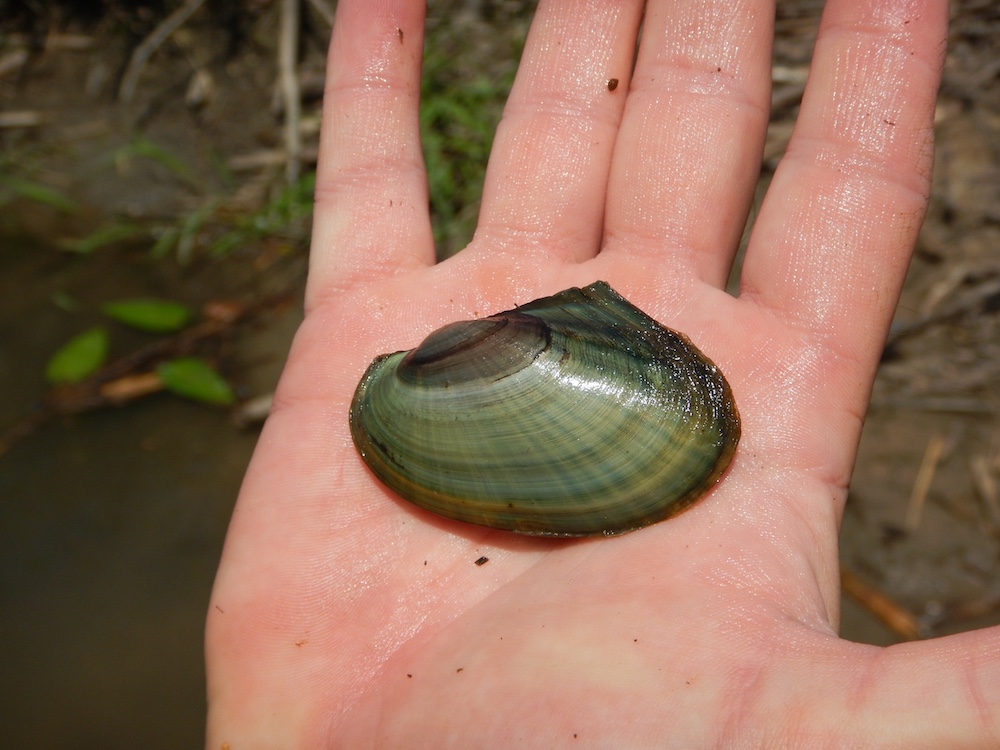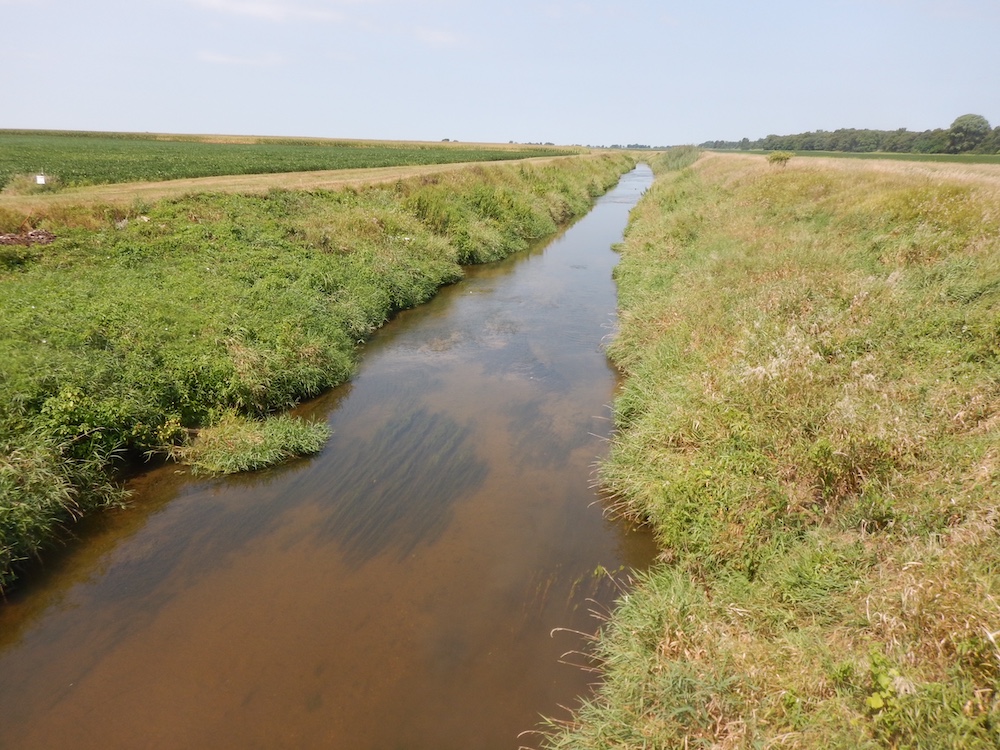
Photo by Ryan Hagerty, USFWS.



Photo by Ryan Hagerty, USFWS.
Hidden within the substrate of streams, rivers, and lakes, freshwater mussels are easy to miss. They go about their business without much notice from humans. But their contributions to the ecosystem and their utility as biological indicators of water quality are under appreciated.
There are approximately 300 species of freshwater mussels in North America. Mussels occur in 49 of the 50 United States, but the majority inhabit drainages of the Mississippi River and Ohio River systems with the greatest species diversity in the southeast United States. It is estimated that 65 percent of mussel species are considered imperiled in North America. Eighty-two species of freshwater mussels have been recorded in Illinois, although only 59 have been observed since 1970, and 11 of those species are each restricted to single river systems. Illinois is home to 24 state-listed threatened or endangered freshwater mussels, 12 of which are also federally listed as threatened or endangered. An additional two mussel species were listed on the Illinois Wildlife Action Plan’s (IWAP) Watch List due to insufficient information to conduct conservation status assessments. Many mussel species rely on limited critical habitat or conservation efforts for survival.

Mussels are filter feeders meaning they siphon water into their bodies, filter bacteria and plankton for consumption, and expel filtered water back into the waterbody. It is estimated that an adult mussel can filter between one and ten gallons of water every day and in doing so clarify and purify our streams and lakes. Mussels also are a food source for some fish and mammals, can stabilize stream and lake substrates, and even serve as substrates for smaller benthic organisms, such as aquatic insect larvae. Mussels grow slowly and may live 30 years or more in the wild. They have a complex life cycle; females expel their young, called glochidia, into the water, which then parasitize the gills of fishes. Glochidia metamorphosize into juvenile mussels and fall from fish to the stream sediments where they mature a few years later and spend the rest of their lives.
Because they are relatively immobile and may take in pollutants while filter feeding, mussels are potentially impacted by many threats associated with anthropogenic activities. Most mussel species are associated with waters that are characterized by continuous flow, stable substrates, and little pollution. Accordingly, landscape disturbance, hydrologic alterations, channel alterations, climate change, pollutants, and invasive species threaten mussels.
Poor or degrading habitat and loss of habitat areas are among the biggest threats to freshwater mussel survival. Aquatic habitat has been lost both due to the construction of dams and channelization which both directly changes habitat. The creation of dams alters the flow of water, often turning shallow water into deep water. This poses a threat as mussels are not adapted to survive in the deep, cold, oxygen-poor water that dams create. Additionally, dams may prevent the migration of fish, thus impacting mussel reproduction as they are reliant on fish hosts. Increased land use for agricultural and urban development also threatens mussels by indirectly altering habitats.
Channelization, increased land use, and urbanization create a potential for erosion and sedimentation which can create unstable sediment for critical mussel habitats. Aquatic habitats may receive pollutants directly from urban, agricultural, or industrial waste, and from landscape runoff. Mussels are intolerant of accumulated silt and loose sediment, much of which originates from surface runoff in agricultural and urban landscapes.

Chemical pollutants, such as ammonia, chloride, and heavy metals, can build up within the organism’s tissues causing changes in morphological and physiological responses or death.
Native mussels have been affected by invasive species such as Asian clams, zebra and quagga mussels, and black carp. Invasive species compete with native mussels for essential resources or consume native mussels. Changes to water flow and quality can also be a result of climate change and increased water demand. Climate change affects mussels by warming the water temperatures and increasing extreme events such as floods and droughts. Water extraction from aquifers, streams, and lakes may result in decreased stream water volume. Water extraction may thus exacerbate the impacts of climate change.
The Illinois Department of Natural Resources (IDNR) and partners, such as the Illinois Natural History Survey and U.S. Fish and Wildlife Service (USFWS), have engaged in the conservation of freshwater mussels. The Streams Campaign of the IWAP identifies strategies for mussel conservation through monitoring and assessments, protection, water quality and flow management, connectivity efforts, and eradication of invasive species. The IWAP, along with the Aquatic Ecology Program of the Division of Natural Heritage, and partners, coordinate and implement conservation efforts for freshwater mussels listed as Species of Greatest Conservation Need (SGCN) and their habitat. Multiple past and current IDNR-funded State Wildlife Grant projects aim to protect and conserve freshwater mussels in Illinois by: collecting baseline data via surveys to fill in knowledge gaps, propagation, relocation, habitat restoration, and analyzing impacts of dams and dam removals. These conservation actions require an understanding of species life cycles and interactions, stressors that impact the species, and the resources that are necessary to sustain viable populations. As a result of assessing the species and their habitat, identifying stressors and threats, and implementing conservation actions, the IDNR and partners work toward maintaining and enhancing freshwater mussel populations.
Along with state efforts, efforts by the USFWS have focused on the identification of research, management, and conservation actions necessary for the maintenance and recovery of healthy mussel populations. Some of these efforts include surveying and monitoring for species occurrence, population trends, threats, habitat restoration, propagation, and invasive species control. Although the FWS performs conservation activities at a national scale they also coordinate with IDNR in removing invasive mussels, propagating Federally endangered species, surveying Illinois’ large rivers, and conducting species status assessments.

The public can contribute to maintaining mussel populations by engaging with conservation partners. Some partners promote approaches to stream conservation while others train volunteers to conduct mussel surveys. For individuals, conserving water, limiting pesticide use, and taking precautions to ensure you are not transporting invasive species on recreation vehicles are approaches to conserving mussels.
Freshwater mussel conservation is dependent upon increasing the understanding of the status, trends, and ecology of species; minimizing threats to species and their habitats; identification and management of suitable habitats; increased advocacy and support; and maintaining populations and communities of mussel species. Execution of these needs on the state and federal levels is necessary to aid in the preservation of rapidly declining freshwater mussels across the country.
Isabella Newingham is the new State Wildlife Action Plan and Aquatic Ecology GPSI intern at the Illinois Department of Natural Resources. She graduated with a bachelor’s degree in Biology from Millikin University in 2020. She spent the year following graduation teaching at a local high school before starting at the University of Illinois Springfield to complete a master’s degree in Environmental Sciences with a concentration in Sustainable Development and Policy. While at Millikin University she completed research to observe behavioral responses in millipedes.
Submit a question for the author